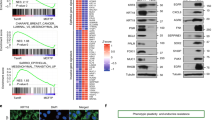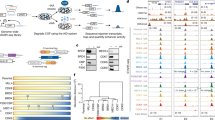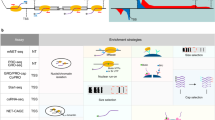Abstract
Mammalian genomes are populated with thousands of transcriptional enhancers that orchestrate cell-type-specific gene expression programs1,2,3,4, but how those enhancers are exploited to institute alternative, signal-dependent transcriptional responses remains poorly understood. Here we present evidence that cell-lineage-specific factors, such as FoxA1, can simultaneously facilitate and restrict key regulated transcription factors, exemplified by the androgen receptor (AR), to act on structurally and functionally distinct classes of enhancer. Consequently, FoxA1 downregulation, an unfavourable prognostic sign in certain advanced prostate tumours, triggers dramatic reprogramming of the hormonal response by causing a massive switch in AR binding to a distinct cohort of pre-established enhancers. These enhancers are functional, as evidenced by the production of enhancer-templated non-coding RNA (eRNA5) based on global nuclear run-on sequencing (GRO-seq) analysis6, with a unique class apparently requiring no nucleosome remodelling to induce specific enhancer–promoter looping and gene activation. GRO-seq data also suggest that liganded AR induces both transcription initiation and elongation. Together, these findings reveal a large repository of active enhancers that can be dynamically tuned to elicit alternative gene expression programs, which may underlie many sequential gene expression events in development, cell differentiation and disease progression.
This is a preview of subscription content, access via your institution
Access options
Subscribe to this journal
Receive 51 print issues and online access
$199.00 per year
only $3.90 per issue
Buy this article
- Purchase on Springer Link
- Instant access to full article PDF
Prices may be subject to local taxes which are calculated during checkout




Similar content being viewed by others
References
Heintzman, N. D. et al. Histone modifications at human enhancers reflect global cell-type-specific gene expression. Nature 459, 108–112 (2009)
Heintzman, N. D. et al. Distinct and predictive chromatin signatures of transcriptional promoters and enhancers in the human genome. Nature Genet. 39, 311–318 (2007)
Pennacchio, L. A. et al. In vivo enhancer analysis of human conserved non-coding sequences. Nature 444, 499–502 (2006)
Visel, A. et al. ChIP-seq accurately predicts tissue-specific activity of enhancers. Nature 457, 854–858 (2009)
Kim, T. K. et al. Widespread transcription at neuronal activity-regulated enhancers. Nature 465, 182–187 (2010)
Core, L. J., Waterfall, J. J. & Lis, J. T. Nascent RNA sequencing reveals widespread pausing and divergent initiation at human promoters. Science 322, 1845–1848 (2008)
Lee, T. I. & Young, R. A. Transcription of eukaryotic protein-coding genes. Annu. Rev. Genet. 34, 77–137 (2000)
Rosenfeld, M. G., Lunyak, V. V. & Glass, C. K. Sensors and signals: a coactivator/corepressor/epigenetic code for integrating signal-dependent programs of transcriptional response. Genes Dev. 20, 1405–1428 (2006)
Lupien, M. et al. FoxA1 translates epigenetic signatures into enhancer-driven lineage-specific transcription. Cell 132, 958–970 (2008)
Gao, N. et al. Forkhead box A1 regulates prostate ductal morphogenesis and promotes epithelial cell maturation. Development 132, 3431–3443 (2005)
Mirosevich, J., Gao, N. & Matusik, R. J. Expression of Foxa transcription factors in the developing and adult murine prostate. Prostate 62, 339–352 (2005)
Kang, Z., Janne, O. A. & Palvimo, J. J. Coregulator recruitment and histone modifications in transcriptional regulation by the androgen receptor. Mol. Endocrinol. 18, 2633–2648 (2004)
Shim, E. Y., Woodcock, C. & Zaret, K. S. Nucleosome positioning by the winged helix transcription factor HNF3. Genes Dev. 12, 5–10 (1998)
Holmqvist, P. H., Belikov, S., Zaret, K. S. & Wrange, O. FoxA1 binding to the MMTV LTR modulates chromatin structure and transcription. Exp. Cell Res. 304, 593–603 (2005)
Crowe, A. J. et al. Hepatocyte nuclear factor 3 relieves chromatin-mediated repression of the α-fetoprotein gene. J. Biol. Chem. 274, 25113–25120 (1999)
Cirillo, L. A. et al. Opening of compacted chromatin by early developmental transcription factors HNF3 (FoxA) and GATA-4. Mol. Cell 9, 279–289 (2002)
Wang, Q. et al. Androgen receptor regulates a distinct transcription program in androgen-independent prostate cancer. Cell 138, 245–256 (2009)
Hurtado, A., Holmes, K. A., Ross-Innes, C. S., Schmidt, D. & Carroll, J. S. FOXA1 is a key determinant of estrogen receptor function and endocrine response. Nature Genet. 43, 27–33 (2011)
Thomsen, M. K. et al. SOX9 elevation in the prostate promotes proliferation and cooperates with PTEN loss to drive tumor formation. Cancer Res. 70, 979–987 (2010)
Wang, H. et al. SOX9 is expressed in human fetal prostate epithelium and enhances prostate cancer invasion. Cancer Res. 68, 1625–1630 (2008)
Ogawa, S. et al. Molecular determinants of crosstalk between nuclear receptors and toll-like receptors. Cell 122, 707–721 (2005)
Lee, H. J., Hwang, M., Chattopadhyay, S., Choi, H. S. & Lee, K. Hepatocyte nuclear factor-3α (HNF-3α) negatively regulates androgen receptor transactivation in prostate cancer cells. Biochem. Biophys. Res. Commun. 367, 481–486 (2008)
Gao, N. et al. The role of hepatocyte nuclear factor-3α (Forkhead Box A1) and androgen receptor in transcriptional regulation of prostatic genes. Mol. Endocrinol. 17, 1484–1507 (2003)
Kagey, M. H. et al. Mediator and cohesin connect gene expression and chromatin architecture. Nature 467, 430–435 (2010)
He, H. H. et al. Nucleosome dynamics define transcriptional enhancers. Nature Genet. 42, 343–347 (2010)
Laitinen, S., Karhu, R., Sawyers, C. L., Vessella, R. L. & Visakorpi, T. Chromosomal aberrations in prostate cancer xenografts detected by comparative genomic hybridization. Genes Chromosom. Cancer 35, 66–73 (2002)
Legrier, M. E. et al. Hormone escape is associated with genomic instability in a human prostate cancer model. Int. J. Cancer 124, 1103–1111 (2009)
Wolf, M. et al. High-resolution analysis of gene copy number alterations in human prostate cancer using CGH on cDNA microarrays: impact of copy number on gene expression. Neoplasia 6, 240–247 (2004)
Garcia-Bassets, I. et al. Histone methylation-dependent mechanisms impose ligand dependency for gene activation by nuclear receptors. Cell 128, 505–518 (2007)
Ingolia, N. T., Ghaemmaghami, S., Newman, J. R. & Weissman, J. S. Genome-wide analysis in vivo of translation with nucleotide resolution using ribosome profiling. Science 324, 218–223 (2009)
Hu, Q. et al. Enhancing nuclear receptor-induced transcription requires nuclear motor and LSD1-dependent gene networking in interchromatin granules. Proc. Natl Acad. Sci. USA 105, 19199–19204 (2008)
Holbro, T. et al. The ErbB2/ErbB3 heterodimer functions as an oncogenic unit: ErbB2 requires ErbB3 to derive breast tumor cell proliferation. Proc. Natl Acad. Sci. USA 100, 8933–8938 (2003)
Heinz, S. et al. Simple combinations of lineage-determining transcription factors prime cis-regulatory elements required for macrophage and B cell identities. Mol. Cell 38, 576–589 (2010)
Barski, A. et al. High-resolution profiling of histone methylations in the human genome. Cell 129, 823–837 (2007)
Linhart, C., Halperin, Y. & Shamir, R. Transcription factor and microRNA motif discovery: the Amadeus platform and a compendium of metazoan target sets. Genome Res. 18, 1180–1189 (2008)
Chandran, U. R. et al. Gene expression profiles of prostate cancer reveal involvement of multiple molecular pathways in the metastatic process. BMC Cancer 7, 64 (2007)
Yu, Y. P. et al. Gene expression alterations in prostate cancer predicting tumor aggression and preceding development of malignancy. J. Clin. Oncol. 22, 2790–2799 (2004)
Varambally, S. et al. Integrative genomic and proteomic analysis of prostate cancer reveals signatures of metastatic progression. Cancer Cell 8, 393–406 (2005)
Glinsky, G. V., Glinskii, A. B., Stephenson, A. J., Hoffman, R. M. & Gerald, W. L. Gene expression profiling predicts clinical outcome of prostate cancer. J. Clin. Invest. 113, 913–923 (2004)
Taylor, B. S. et al. Integrative genomic profiling of human prostate cancer. Cancer Cell 18, 11–22 (2010)
Acknowledgements
We are grateful to H.-J. Kung for providing the PC3-AR cell lines, C. Sawyers for providing the LNCaP-AR cell line, and J. Hightower, D. Benson and M. Fisher for assistance with figure and manuscript preparation. This work was supported by grants from US Army Medical Research and Material Command (grant W81XWH-05-1-0100) to I.G.-B., the National Institutes of Health (DK01847, DK37949, DK074868, NS34934), Department of Defense and the National Cancer Institute (CA97134) to M.G.R.; the National Institutes of Health (GM049369 and HG004659) to X.-D.F.; and the Prostate Cancer Foundation to M.G.R. and X.-D.F. M.G.R. is an investigator of the Howard Hughes Medical Institute.
Author information
Authors and Affiliations
Contributions
D.W., I.G.-B., M.G.R. and X.-D.F. designed the experiments; D.W. and I.G.B. performed most of them. C.B. performed all computational analyses. W.L. and M.K. performed GRO-seq; X.S. performed the 3C assay; Y.Z. analysed human samples; and J.Q. performed proliferation assays. K.A.O. and W.L. generated AR constructs. I.G.-B., D.W., M.G.R. and X.-D.F. wrote the manuscript with contributions from C.B. and C.K.G.
Corresponding authors
Ethics declarations
Competing interests
The authors declare no competing financial interests.
Supplementary information
Supplementary Figures
This file contains Supplementary Figures 1-25 with legends. (PDF 1973 kb)
Rights and permissions
About this article
Cite this article
Wang, D., Garcia-Bassets, I., Benner, C. et al. Reprogramming transcription by distinct classes of enhancers functionally defined by eRNA. Nature 474, 390–394 (2011). https://doi.org/10.1038/nature10006
Received:
Accepted:
Published:
Issue Date:
DOI: https://doi.org/10.1038/nature10006
This article is cited by
-
Clinically-observed FOXA1 mutations upregulate SEMA3C through transcriptional derepression in prostate cancer
Scientific Reports (2024)
-
Comprehensive profiling of enhancer RNA in stage II/III colorectal cancer defines two prognostic subtypes with implications for immunotherapy
Clinical and Translational Oncology (2023)
-
FOXA1 can be modulated by HDAC3 in the progression of epithelial ovarian carcinoma
Journal of Translational Medicine (2022)
-
Protocol variations in run-on transcription dataset preparation produce detectable signatures in sequencing libraries
BMC Genomics (2022)
-
Dynamic enhancer transcription associates with reprogramming of immune genes during pattern triggered immunity in Arabidopsis
BMC Biology (2022)
Comments
By submitting a comment you agree to abide by our Terms and Community Guidelines. If you find something abusive or that does not comply with our terms or guidelines please flag it as inappropriate.



